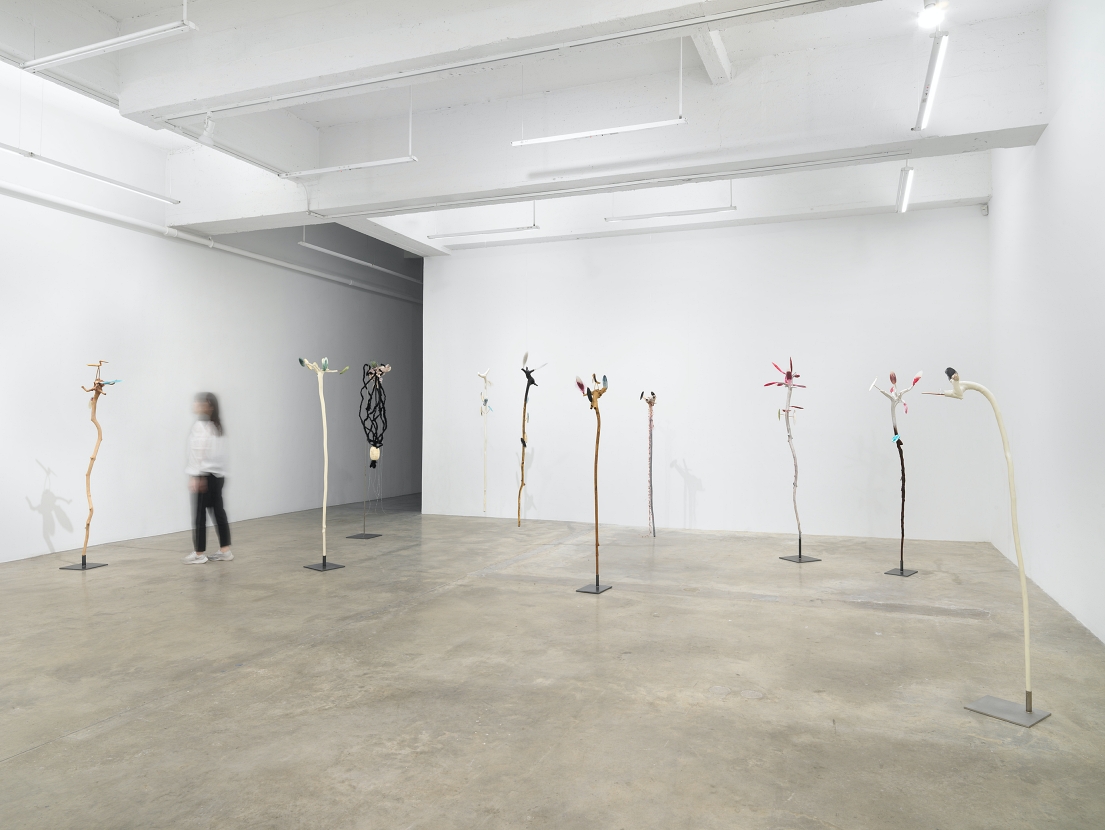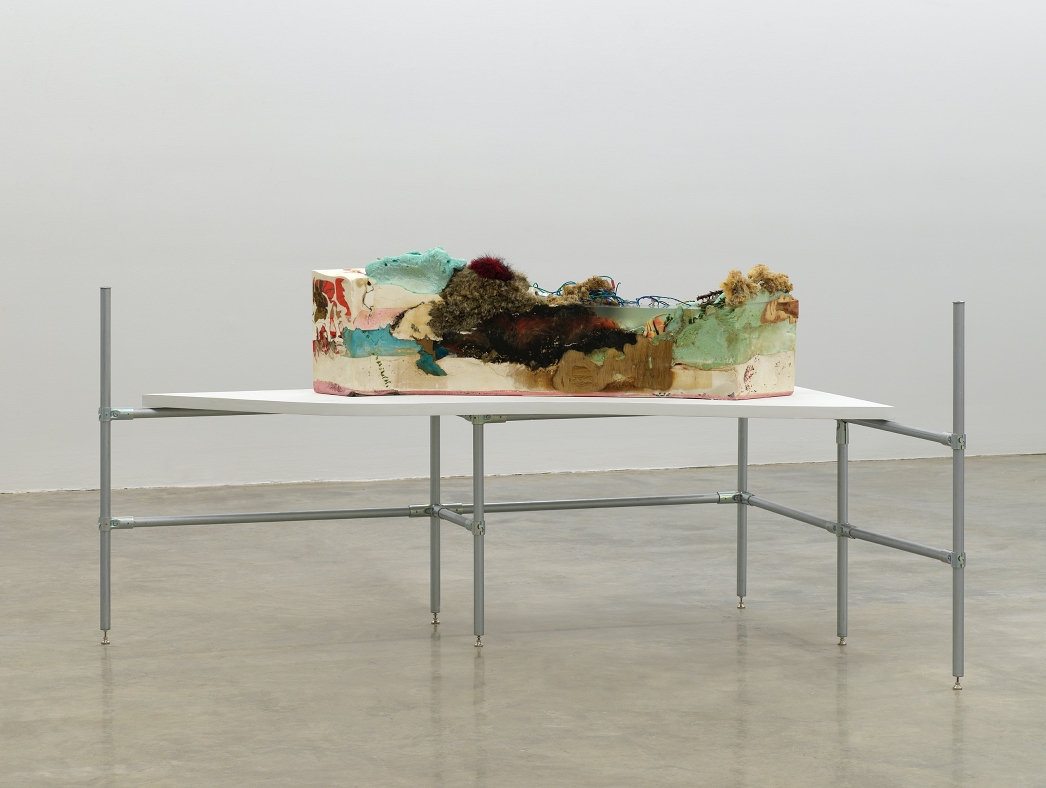Minouk Lim Solo Exhibition Fossil of Highnoon
2022. 5. 19 - 7. 1
Tina Kim Gallery, New York
임민욱 개인전 정오의 화석
2022. 5. 19 - 7. 1
티나킴 갤러리, 뉴욕


Installation view of Minouk Lim: Fossil of High Noon
2022, Tina Kim Gallery, New York
Courtesy of the artist and Tina Kim Gallery
Photo: Dario Lasagni

Fossil of High Noon is paradoxical.
The sun of high noon makes the shadows that fall to the ground the darkest. A fossil in itself is close to a ghost-state. A space without location is born as it approaches the present without notice, though it has existed since the deep past. The simultaneous and fragmentary heterochrony remind us of time’s irreversibility. This exhibition is about departure due to spatial and temporal discrepancies, while simultaneously containing the possibility of reunion.
Fossil of High Noon alludes to today’s world; hatred, war, terrorism, globalization, refugees (located in non-places), climate change, and diseases repeat in an endless cycle.
Minouk Lim (b. 1968) continues to center aesthetics and politics in her artistic practice, rejecting binaries of subject and other; individual and community; documentary and fiction; assailant and victim; active and passive. Lim has stated that aesthetic practice provides imperative new models by which to criticize histories of omission, as well as to formulate new avenues of questioning.[1] She explores measurements of time in unchronological order and reexamines signs emerging from the midst of oblivion through suspicion and speculation. From a sculpture in a non-fixed and fragile form, a sound that flows and disappears, a video that aligns facts and fictions in jump cuts, a performance that becomes complete with the assembly of bodies and witnessing, to a piece in which each of these mediums interacts with and translates one another, Lim’s media works translate the hidden voices and figures of history through the “readjustment of senses.” Critic Namsee Kim has referred to Lim’s approach to media as psychic, in that her works “track down the disappeared and the invisible” through a state of being “fluid, disappearing, and invisible.”
The work Portable Keeper_Sea begins with a bird’s eye view. Buoy sea markers wander around a swimming girl and form a distinctive territory. The girl submits her body to the waves of the sea, a skirt and jeogori[2] weltering under the water, creating a parallel. Between the sky and the sea; above and below water; tradition and the present; memory and future; life and death; the camera sutures these binaries and allows estranged generations to coexist in an alternate dimension. The low bell chimes in the video scatter on, taking over one another’s howling echo. Buddhist wind chimes in the shape of a carp fish allude to a proverb, “Fish do not close their eyes even in sleep,” an effort to both stay awake and devote oneself to self-discipline. Lim’s grandmother, who stood alone without solitude, taught her self-organization and the “power of imagining the unseen”.
Dudu Mulmul, sculptures installed along with the video, contains a diverse assortment of miscellanea that could have arrived at any or all seashore(s) in the world. Each object embodies an uncertain secret of when, where, and how it came to be there. The confluence of these fragments of time-space becomes a sculpture with fluid materials such as transparent resin. Critic Harry C. H. Choi mentioned,
“Lim imagines a medium that resists stasis and is constantly in the process of formation and articulation—one that could be characterized as a model of sculpture as verb… the artist’s sculptures could be construed as literally producing actions and reactions in the present continuous, as they assume the possibility of being morphed and re-arranged, seek to deliver memories of the past, and resist pre-existing customs of the medium.”[3]
These works are also accompanied by Discreetly, a spiraling frame or door-shaped form with a layered set of allusions in its title, spanning from a nameplate centered at the top of the sculpture. The Korean "sori-somun" ("sound-rumor") is written on the nameplate, referencing an idiom that translates "without any sound or rumor," meaning "stealthily" or "without revealing." Lim complicates this idiomatic gesture by excluding the Korean word for "without" from the title, allowing the connotation of "discreet" to mingle with the idea of a small gateway for a sound. If Lim's Portable Keeper illustrate an inclination toward movement, continuation, circulation and conversion of states of being, the work instead speaks to the simultaneous gestures of the invisible and the separable.
In the front gallery, Lim showcases her new liquid drawing series Dudu, using fluid and heat sensitive materials such as resin as a thin, transparent bed for strands of nylon adorned with protruding thorns.
Directly facing the drawing, her new Portable Keeper pieces in this exhibition appear as though dredged from an era of dinosaurs or forgotten kings. The cane resembles animals with bones and feathers, neither natural nor artificial. The senses that evaporate, scatter, or shatter before making sense in the world, the byproducts of a fragile world that can only be felt by fumbling, lend their bodies and senses to the canes and form an antithesis of compassion. The victims who were massacred without knowing in the standoff of the ideological camps; brothers separated in war and forgetful of each other’s names and faces; the lives that have embraced and endured what still cannot be said are far from living in a clear or simple world. The subtle chime of a bell in the wind, the intangible waves of shimmering heat, and the world after parting all address us through not language, but senses.
Like the cuckoo in the clock that never fails to tell the time, even in an empty house, Portable Keeper mourns the scattering hopelessness of oblivion.
[1] Clara Kim. Journeys of the 25th Hour, Jun 1, Walker Reader, 2012
[2] Korean traditional jacket, upper garment of Korean traditional clothes
[3] Harry C. H. Choi, “Sculpture as Verb: Notes on Minouk Lim’s Material Praxis,” in Night Shift, exh. cat., ed. Minkyung Yoo. Seoul, Korea: Seoul Museum of Art, 2022.
-Text by Danji Lee
<정오의 화석>은 흘러가는 시간의 법칙을 거스른다.
셈 할 수도 없는 시간의 긴 침묵 속에서 굳어진 화석과 땅으로 떨어지는 그림자들이 가장 짙게 어두워지는 한나절의 조우. ‘정오의 화석’은 역설적이다. 화석은 자체로 유령에 가깝다. 그것은 주소가 없는 공간이며 과거부터 있어왔지만 현재에 다다를 때에만 예고 없이 태어난다. 옛날 옛적 일을 우리 앞에서 반복하며 결코 되풀이될 수 없는 사건들을 진행형으로 꺼내 놓는다. 임민욱이 제안한 이 전시의 제목은, 끝나지 않고 되풀이되는 반목과 혐오, 전쟁과 테러리즘, 세계화와 (비-장소에 위치한) 난민, 기후변화와 질병적 재난이 휩쓸며 문명이 퇴보하고 있는 지금의 세계와, 우리의 상황과 겹쳐진다. 정오와 화석, 이 둘의 동시적이고 파편적인 이시성(異時性)은 시간의 비-가역성을 일깨워준다.
1945년 8월 15일, 한반도의 나라는 식민 지배자로부터 벗어나는 동시에 반도의 허리를 둘로 나누었다. 소년이었던 시인[1] 은 식민의 세월 속에 모어(mother togue)를 잃어버렸다. 광복 이후 6.25 전쟁과 남한정권의 탄압을 피해 일본으로 밀항을 감행한 그는 남에도 북에도, 일본 땅에서조차, ‘있지만 없다고 여겨지는’ 사람(자이니치/在日)이 되었다. 고향 섬에 만세소리가 울려 퍼지던 그 날에 대해, 김시종은 훗날, ‘한나절의 해방’이었다고 고백한다.[2] 지배자의 말(Japanese) 밖에 읽고 쓸 줄 모르던 소년은 충격적인 해방의 한나절을 ‘그 어떤 빛깔도 바래지고 마는/하얗게 튀어 오르는 헐레이션 (hallation)의 계절’ 이었다고 썼다.
역사(歷史)는 우리를 비추는 명징한 거울이 될 수 없다.
임민욱은 주체와 타자, 개인과 공동체, 다큐와 픽션, 가해자와 피해자, 능동과 수동과 같은 이분법적인 수사를 거부하며 미학과 정치 사이에서의 예술실천을 이어왔다. 작가는 누락의 역사를 비판하기 위한 새로운 방법, 전승에 관한 질문을 던지는 방법으로의 미학 실천을 찾아야만 한다고 말한 바 있다.[3] 역사와 환경으로부터 파생된 시간의 조각들을 비선형적으로 탐문하는 작가는 의심과 추측을 통해 망각의 질서에서 나타나는 징후를 재조명한다. 식민주의, 전쟁, 분단을 겪은 이데올로기 진영의 대립(standoff) 속에서 영문도 모르고 학살된 희생자, 전쟁통에 헤어져 서로의 이름도 얼굴도 잊어버린 형제, 여전히 말할 수 없음을 끌어안고 버텨내 온 삶들은 명확하거나 단순한 세계와 거리가 멀다. 작가는 타자에 대한 일반화를 거부하며 윤리적 태도에 가까운 입장으로 미디어를 사용한다. 비-고정적이며 연약한 형태의 조각, 흘러가고 사라지는 사운드, 사실과 허구를 점프 컷으로 배열하는 비디오, 사람들의 신체와 증언하는 목소리의 집합으로 완성되는 퍼포먼스, 그리고 각 매체가 상호 교차하여 서로를 번역하는 작업에 이르기까지, 임민욱의 미디어는 ‘감각의 재조정’을 통해 역사의 감추어진 목소리와 형상을 대변한다. 비평가 김남시는 임민욱의 미디어를 ‘흐르고 사라지며 보이지 않는’ 상태를 통해 ‘사라진 것, 비가시적인 것을 추적’하는 영매(靈媒)적 미디어라고 말했다.
이번 전시, <정오의 화석>은 시간과 장소가 어긋난 작별과 재회의 가능성에 관한 것이다.
수원시립미술관에서 처음 선보인 영상작업 <봉긋한 시간>은 수 천년은 족히 되었을 바다 밑 바위와 해초를 먼 부감으로 보여주는 장면으로 시작한다. 동그랗게 꿰어진 부표들은 커다란 목걸이처럼 헤엄치는 소녀의 주변을 떠돌며 어떤 영토를 만들고 있다. 수면의 파동에 몸을 맡기는 소녀와 바다 아래서 넘실거리는 고운 색의 치마 저고리가 평행적인 위치를 이룬다. 하늘과 바다, 전통과 현재, 할머니와 손녀, 기억과 미래, 삶과 죽음 사이, 물 위와 물 밑을 바느질하듯 이어 붙이는 카메라는 서로 같은 시공간을 살지 않았던 불-연속적인 세대를 다른 차원의 방식으로 공존하게 한다. 생전에 임민욱에게 “상상력의 원천”이 되어주었던 할머니는 불교에 귀의하셨다고 했다. 부처님이 계신 절의 처마 끝에는 바람이 부는 대로 흔들리며 종소리를 내는 붕어 모양의 풍경(風磬)이 매달려 있다. “물고기는 잠 잘 때도 눈을 감지 않는다”는 풍경의 의미는 언제나 깨어 있어 수행에 몰두하라는 불교적 가르침이다. 손녀와 할머니의 오가지 못한 마지막 대화의 문장은 엘렌 식수의 <메두사의 웃음>[4] 과 같은 고백 같은 것이지 않았을까 상상해본다. 죽음으로 작별한 할머니에 대한 그리움을, 작가는 자신의 딸과의 조우를 주선하며 재회하는 것이다. 영상에서 흘러나오는 장영규의 낮은 종소리는 서로의 하울링을 이어받아 흩어져간다.
영상과 함께 설치된 조각, ‘두두물물(頭頭物物)’은 세상의 모든 것을 가리키는 한자 삼라만상에서 따왔다. 지구의 모든 해안가에 파도를 타고 도착한 뜬금없는 사물들도 이만큼이나 다양할 것이다. 사진, 여행용 칫솔세트, 인조 식물, 장난감, 머리카락, 색연필, 냅킨, 그리고 심지어, 먹다 만 와플, 캥거루 해골, 이어폰, 엄나무 조각, 우동 사리… 눈에 보이는 것만 나열해봐도 끝이 없다. 각각의 물건들은 그 모습과 쓰임이 제각각 일 뿐 아니라, 언제/어디서/어떻게 흘러왔는지 정확히 알 수 없는 비밀을, 각자의 시간성을 가진다. 과거와 미래, 현재를 왕복하(고 있)는 시공간의 물건들이 투명한 레진, 형광색의 폴리우레탄, 석고와 같은 화학적 액체들과 함께 한 몸의 조각이 된다. 비평가 최장현은 “정지된 상태라는 조각의 관습을 저항하는 과정을 통해 단순히 현재라는 시제에 머물러 있지 않고 과거와 미래를 표현할 수 있는 개체로 동사적 조소의 가능성”을 언급하였다.[5] 이번 전시에서 처음 발표되는 임민욱의 신작 드로잉에서도 이러한 성격은 반복된다. 오징어뼈 위에 종이를 올려놓고 색연필로 문질러 그린 드로잉 연작은 이미지를 재현하는 것이 아니라 ‘거기에 있었던’ 사물의 신체를 종이라는 바탕에 촉감적으로 옮긴다. 프로타주 방식을 통해 시간과 공간의 층위를 드러내는 것이다.
임민욱의 또 다른 조각 연작, <포터블 키퍼>는 2009년 서울의 재개발 지역이었던 모래내 시장 주변의 공사장과 골목길에서 촬영된 동명의 퍼포먼스에서 처음 등장했다. 이후 현재까지 비디오, 조각, 퍼포먼스 등 여러 형태로 발표되고 있다. 이번 전시의 <포터블 키퍼> 신작은 공룡의 시대이거나 잊혀진 왕들의 시대로부터 온 것 같은 형상이다. 뼈와 깃털이 있는 동물을 연상시키는, 자연도 인공도 아닌 모습이다. 그릇에 떠 놓은 물에도 소원을 빌었을 시절, 오래된 집이나 무덤가에서 나타나는 도깨비불이 이렇게 생기지 않았을까. 조각에 사용된 지팡이들은 1949년 문경 양민학살의 생존자인 故 채의진님의 목공조각을 임민욱이 기증받아 재구성한 것이다. 2014년 광주 비엔날레에서 <채의진과 1000개의 지팡이>(2014-2020)로 소개되었고 지난 해(2021) 서울시립미술관 전시 <교대>에서는 <새가 날아가서, 나무가 된 나무>가 되었다. 이번 전시 <정오의 화석>에서 지팡이는 오징어뼈, 부표, 구슬, 인조 깃털, 낚시 끈, 엄나무 가시와 같은 재료와 함께 재구성되었고 독립된 존재로 번역되었다. 세상에서 의미를 이루기도 전에 증발하거나 흩어지거나 부서지는 감각, 더듬어 만져야 하는 연약한 세계의 부산물들은 지팡이에게 그들의 몸과 감각을 빌려주며 연민의 대구를 이룬다. <포터블 키퍼>는 이별 이후의 세계를 향한 수신자로, 또는 발신자로, 혹은 아무도 없는 집에서 시간마다 울기를 멈추지 않는 벽시계 속의 뻐꾸기처럼 속절없이 흩어지는 망각을 애도한다.
[1] 재일 시인 김시종(1929~)은 어린 시절을 제주에서 보내며 17살에 4.3에 연루되었다. 스무 살 때인 1949년, 살아남기 위해 제주에서 일본으로 밀항, 남‧북한 어느 국적도 선택하지 않은 채 ‘조선적’ 재일조선인으로 살았던 그는 1998년 50년 만에 고향을 찾았다. 2003년 제주에 있는 부모님의 묘소를 찾기 위해 한국적을 취득했다.
[2] “8월 15일이 해방의 날이라는 건, 저의 경우는 엄밀히 말하면 한나절의 해방이지요. 오전 내내 저는 제국, 황국 소년이었어요. 되살아났다는 조국도 8월 15일 오전 중에는 아직 식민지 통치하에 있었습니다. (중략)그러니까 8월 15일 하루 전부가 ‘저’의 해방이었던 게 아니라 엄밀히는 오전 내내 황국소년이었던 저였어요.” 김시종, 『왜 계속 써왔는가 왜 침묵해 왔는가』, 2007, p.163
[3] Clara Kim. Journeys of the 25th Hour, Jun 1, Walker Reader, 2012
[4] “She is incomprehensible, even to herself. That got her anxious for a long time. The fact that ‘she couldn’t understand herself’, and that she didn't know herself, seized her with a sense of guilt.” 앨런 식수, ‹메두사의 웃음/출구›, 1975 Excerpts of Hélène Cixous, The Laugh of theMedusa, 1975
[5] 동사로서의 조소-임민욱의 질료적 상상력, 최장현
-글 이단지